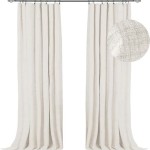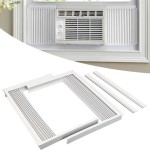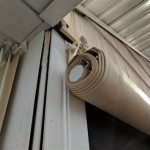What is an Air Curtain?
An air curtain, also known as an air door, is a device that creates an invisible barrier of air across an opening. This barrier effectively separates two distinct environments, typically preventing the exchange of air, temperature, humidity, and contaminants between the spaces. Air curtains are commonly installed above doorways, loading docks, and other entry points to maintain interior climate control, improve hygiene, and enhance energy efficiency.
The fundamental principle behind an air curtain's operation involves generating a controlled stream of air that is directed downwards or across an opening. This air stream acts as a seal, resisting the flow of air from one side of the opening to the other. Air curtains are not designed to completely seal an opening, but rather to minimize air exchange significantly, acting as a dynamic barrier rather than a static one.
Air curtains are available in various sizes, configurations, and strengths, tailored to suit different applications and opening dimensions. Choosing the correct air curtain for a specific application requires careful consideration of factors such as door width, door height, expected traffic volume, and the environmental conditions that need to be controlled.
Key Point 1: Functionality and Operation
The core function of an air curtain is to create a separation between two spaces by using a moving air stream. This air stream is typically generated by a fan or blower system housed within the air curtain unit. The air is drawn in through an intake, typically located at the top or back of the unit, and then forced through a nozzle that directs the air downwards or across the opening.
The velocity and direction of the air stream are critical to the effectiveness of the air curtain. The air stream must be strong enough to overcome external forces such as wind pressure or temperature differentials that could disrupt the barrier. The angle of the nozzle is also carefully calibrated to ensure that the air stream reaches the floor or the opposite side of the opening with sufficient force to effectively block airflow.
Many modern air curtains incorporate advanced features such as variable speed controls and automated sensors. These features allow the air curtain to adjust its performance based on real-time conditions, optimizing energy efficiency and maintaining the desired level of separation. For example, an air curtain might increase its fan speed during periods of high traffic or when a significant temperature difference exists between the inside and outside environments.
Air curtains can be classified into two main types based on their airflow pattern: recirculating and non-recirculating. Recirculating air curtains draw air from the room and recirculate it back into the air stream, while non-recirculating air curtains draw air from outside and exhaust it back to the outside. Recirculating air curtains are generally more energy-efficient, as they do not require conditioning outside air. However, non-recirculating air curtains may be preferred in environments where hygiene is a paramount concern, as they prevent the circulation of airborne contaminants within the space.
The effectiveness of an air curtain in preventing air exchange is influenced by several factors, including the air curtain's design, installation, and operating parameters, as well as the environmental conditions surrounding the opening. Proper installation is crucial to ensure that the air stream is properly aligned and that there are no gaps or obstructions that could compromise its effectiveness. Regular maintenance, such as cleaning the air filters and inspecting the fan blades, is also essential to maintain optimal performance.
Key Point 2: Applications and Benefits
Air curtains find application across a wide range of industries and settings, offering numerous benefits that contribute to improved energy efficiency, hygiene, and comfort. Their ability to effectively separate different environments makes them a valuable tool in any situation where controlling airflow is important.
In the food service industry, air curtains are commonly installed above doorways to prevent the entry of insects, dust, and other contaminants into kitchens and dining areas. This helps to maintain sanitary conditions and protect food from spoilage. They also help regulate temperature and humidity levels, creating a more comfortable environment for customers and employees.
Retail stores often use air curtains to reduce energy costs by preventing the loss of conditioned air through open doorways. This is particularly important in climates with extreme temperatures, where heating or cooling costs can be significant. Air curtains can also help to improve customer comfort by reducing drafts and maintaining a consistent temperature throughout the store.
Warehouses and loading docks are another common application for air curtains. In these environments, air curtains help to prevent the entry of cold air, rain, and snow, protecting workers and preventing damage to goods. They also help to improve safety by reducing the risk of slips and falls caused by wet or icy floors.
Beyond these common applications, air curtains are also used in specialized settings such as hospitals, cleanrooms, and cold storage facilities. In hospitals, air curtains help to maintain sterile environments and prevent the spread of airborne infections. In cleanrooms, they help to prevent the entry of dust and other contaminants that could compromise sensitive manufacturing processes. In cold storage facilities, air curtains help to reduce energy costs by preventing the loss of cold air and maintaining a consistent temperature within the facility.
The benefits of using air curtains extend beyond energy savings and improved hygiene. They can also contribute to a more comfortable and productive work environment, reduce noise levels, and improve overall building aesthetics. In some cases, air curtains may also be required by building codes or regulations, particularly in food service and healthcare facilities.
Key Point 3: Types and Features
Air curtains are available in a variety of types and configurations, each designed to meet the specific needs of different applications. The selection of the appropriate air curtain depends on factors such as the size and type of opening, the environmental conditions, and the desired level of performance.
As previously mentioned, air curtains can be classified as either recirculating or non-recirculating. Recirculating air curtains are generally more energy-efficient and are suitable for applications where hygiene is not a primary concern. Non-recirculating air curtains are preferred in environments where hygiene is critical, as they prevent the circulation of airborne contaminants.
Air curtains can also be classified based on their mounting location. Some air curtains are designed to be mounted above doorways, while others are designed to be mounted on the side of the opening. Overhead-mounted air curtains are the most common type and are suitable for a wide range of applications. Side-mounted air curtains are often used in situations where there is limited headroom or where an overhead installation is not feasible.
In addition to these basic types, air curtains are available with a variety of features that enhance their performance and functionality. These features may include:
- Variable Speed Controls: Allow the air curtain's fan speed to be adjusted based on real-time conditions, optimizing energy efficiency and maintaining the desired level of separation.
- Automated Sensors: Detect the presence of people or objects and automatically activate or deactivate the air curtain.
- Heated Air Curtains: Provide supplemental heat to the air stream, improving comfort in cold environments.
- Air Filters: Remove dust and other contaminants from the air stream, improving air quality.
- Remote Controls: Allow the air curtain to be controlled from a distance.
- Custom Finishes: Available in a variety of colors and materials to match the building's aesthetics.
The construction materials of an air curtain are also an important consideration. Typically, the casing is made of steel, stainless steel, or aluminum. Stainless steel is often favored in food processing or healthcare environments due to its corrosion resistance and ease of cleaning. Fan blades are usually made of aluminum or plastic. The nozzle design, crucial for directing the airflow, varies depending on the intended application and can influence the air curtain's performance and noise level.
Selecting the right air curtain requires careful consideration of all these factors. Consulting with a qualified HVAC professional can help ensure that the chosen air curtain is properly sized and configured for the specific application, maximizing its effectiveness and minimizing energy consumption. Thorough research and comparison of different models are also advised before making a purchase decision.

Air Curtains What Is An Curtain 101 Berner

6 Benefits Of Using Air Curtains In Buildings

What Is An Air Curtain And Its Purpose

10 Reasons To Install An Air Curtain In Your Premises

What Does An Air Curtain Do

Air Curtain S Horizontal Vertical Ambient Heated

What Is Air Curtain The Magic Of Kdk Curtains

Air Curtain Basics What Is An How Does It Work Flexiheat Uk

Learn About The Air Curtain Er S Guide Kcvents Ventilation System

How Air Curtains Work








